
Microsoft Surface Pro 3 Windows 8.1 tablet
Microsoft has made many changes to the Surface Pro, and they're all great. This is an excellent tablet
Pros
- Screen quality and resolution
- Light and comfortable to hold
- Kickstand
Cons
- Capacitive Windows Home key
- Type Cover is an option
Bottom Line
It's hard to go past the Microsoft Surface Pro 3 if you're after a tablet that can be used not only for media consumption, but also for doing real work. The hardware is excellent, the speed is laptop-like, and the user comfort level is high. Without a doubt the best Windows 8 tablet to own, and one that can be used relatively easily as a laptop if you get the optional keyboard cover.
-
Price
$ 1,549.00 (AUD)
Saying that the Surface Pro 3 is the best Windows tablet on the market isn't a stretch, and it shouldn't come as a surprise. Microsoft has built on the Surface Pro 2 in a big way, starting with the screen size, and ending with the adjustable kickstand. It's a product that feels comfortable to use as a tablet; it's also not bad at all as a laptop thanks to its new physical features and a strong configuration. And these are the most important things, especially since Microsoft is touting it as a laptop replacement for people who want to get stuff done.
Bigger, faster, more beautiful
Compared to the previous model, the Surface Pro 3 gets a boost both in screen size and in resolution, with the new model featuring a 12in screen that has a 2160x1440-pixel resolution (the Surface Pro 2 is a 10.6-incher with 1920x1080 pixels). For viewing photos and videos, this screen is a delight. It has a wide viewing angle that can make it easy to see content on the screen regardless of the orientation at which the unit is being held, and colours are rendered vibrantly and with excellent contrast. The only drawback that we noticed during our tests was some reflectivity in our office environment, which is present in all tablets anyway, and we feel like it could use a slightly higher brightness level.
Despite the bigger screen, it's a light tablet, weighing in at 795g on its own and having a thickness of only 9mm. You have to remember that this actually has an Intel Core i5, fourth-generation CPU in it (an i5-4300U running at 1.9GHz), and it's surrounded by 8GB of DDR3 SDRAM, and a 256GB solid state drive (SSD). For all intents and purposes, it's a full-on 64-bit Windows 8.1-based computer system on which you can run your full version of Office and many other Windows programs that you are already used to. It's not a cut-down tablet that you can only use for media consumption.

It's this CPU power that partly enables Microsoft to claim that the Surface can be a laptop replacement. The other part of that argument is due to the larger screen and resolution, and some further physical improvements that Microsoft has made: the kickstand now has a more 'freestyle' pair of hinges that allow the tablet to be used at a great deal more angles than the previous model (which only offered two fixed angles), and the keyboard attachment (Surface Pro Type Cover), has a new magnet design that elevates it a little at the rear so that you don't have to type with the keys resting completely flat on the desk.
Surface Pro Type Cover
The keyboard cover is a major part of the overall experience that the Surface Pro 3 can provide, but it doesn't actually ship with the Surface. Microsoft has made it an optional accessory, citing that people want a greater choice of colours, rather than the limited choice that the bundled product gave them. This way, you are free to select the colour that you want for your keyboard, be it cyan, red, purple, black, or blue. We used the black version for our review, which contrasts nicely with the grey back of the Surface. That, along with the backlight for the keys, as well as a more rigid frame and a slightly larger touchpad, all make for an enjoyable typing experience that can rival an Ultrabook when you’re resting the unit on a desk.
 Credit: Supplied
Credit: Supplied There is nothing stopping you from using the Surface with the Type Cover while resting it on your lap either. However, it’s clearly not as comfortable as a typical laptop for this task due to the extra parts that are involved, and the extra space that they require. For example, you have to be mindful that the keyboard is ‘loose’ and not actually part of the ‘laptop’, and then you have to remember that the kickstand needs space behind the screen to rest properly on your legs. It’s not an ideal unit to use if you’re fidgety or prone to changing your seating position, but you can definitely work with it, even while you're lazing on the couch.
The magnet that holds the Type Cover in place is very strong, and just like the previous Surface tablets, you can hold it upside down by the keyboard and not have it fall off and die (though all bets are off if you shake it or do something else to invite disaster). An extra fold and another strong magnet along the spine are what allow the keyboard to sit at a slight slant, and this typing position makes a tremendous difference. It’s a surprisingly strong keyboard in this elevated position, and there is only the slightest movement in the centre of the keyboard as you type.
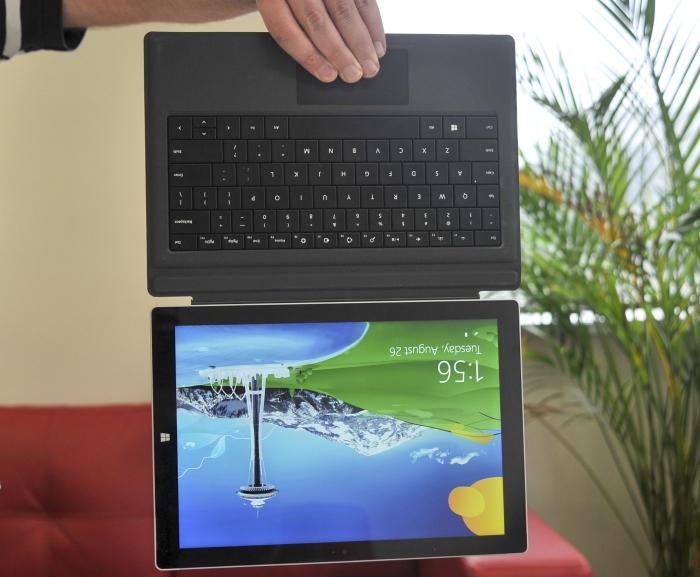
For the touchpad, you now get physical left- and right-button clicks, and it’s a pad with a decent size (88x43mm) considering the constraints in which Microsoft has had to work (the palm rest is 63mm deep). That said, it’s only a basic touchpad that doesn’t support some multi-finger gestures such as three-finger swipes (at least our review model didn’t, though two-finger scrolling worked), and it can sometimes feel a little slow to respond at the beginning of a movement. Overall, though, it’s a good pad for traversing the 1440p resolution of the screen.
With the Type Cover attached, the weight of the Surface Pro 3 becomes 1.1kg, which excellent for portability, and combined with the small power adapter that ships with the tablet (it’s only 90x50x22mm and it has a USB port built in for charging) you barely feel it when carrying it around in a backpack. We do wish that the Surface Pro Type Cover was supplied by default, instead of incurring an extra cost, but at $150 ($200 in New Zealand) we think it’s worth it and that the Surface Pro 3 would feel incomplete without it.
The Type Cover also comes with a little tab that includes a holder for the pen that ships with the Surface. You can stick this holder on the side of the Type Cover and store your pen in it, and it’s the only real solution for housing the pen, since there is no dedicated space for it on the tablet itself. However, we did notice that you can also use the power socket’s magnet as a makeshift holder for the pen. That’s only useful for when the tablet is stationary on a desk, as it’s too easy to knock it off when moving or holding the tablet.

Of course, you also can’t store the pen there when the power is connected. The magnet is designed to provide a strong hold for the rectangular power connector, and it’s also useful for guiding the connector into the slot. You need some guidance to make it easier to connect the power, mainly due to the rectangular shape of the connector, and also the slight angle at which the connector resides. The power plug is plastic and now slots into the body for a firmer connection than before.
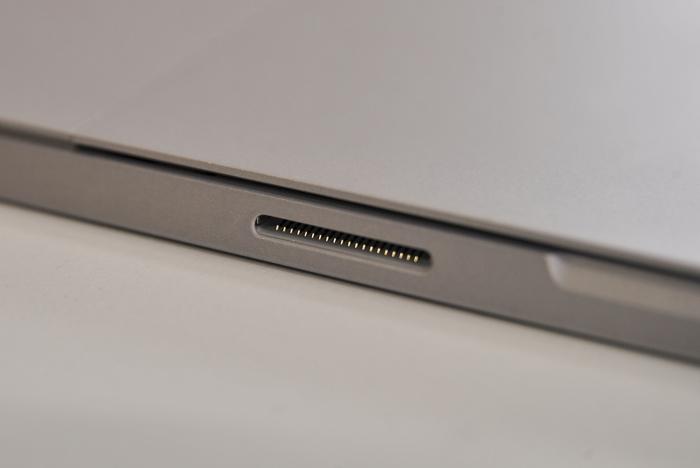
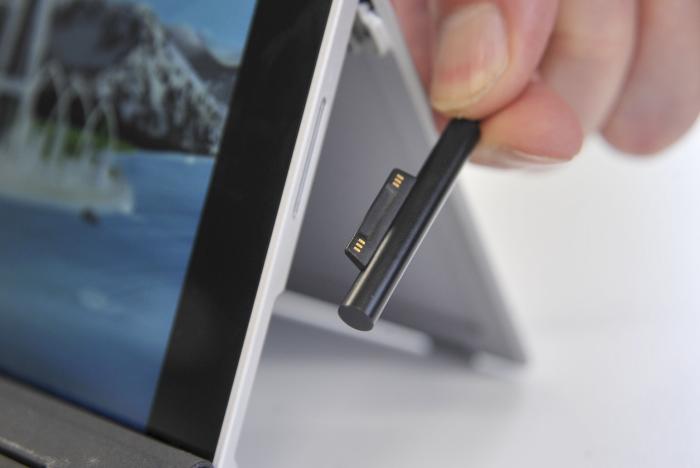

Due to the silver finish on the magnesium body, you are less likely to notice scratches around the port areas and the edge of the kickstand. The black paint job on the Surface Pro 2 was poor in this respect, as scratches around the power connector and the kickstand edges in particular became a tell-tale sign of wear and tear. You can still see some slight scratching on the edge of the kickstand, but only if you look hard enough. It won’t stand out like it did on the Surface Pro 2.
Pen usage, hinge action
Using the Surface Pro 3 for handwriting and drawing is a pleasure on the new screen, and the pen that's supplied with it travels freely across the Gorilla Glass 3 with barely any resistance. Furthermore, the screen is bonded to the glass, which means that there is no gap between the two parts, and the action of the pen touching the 'paper' feels a lot more natural. Indeed, we think it's a great device on which to take handwritten notes, and paint or sketch.

Palm rejection worked well during our review, and Windows 8.1's built-in handwriting recognition did an admirable job (as it usually does) with our mostly horrible handwriting — though the most common error we noticed was it thinking we wrote 'hells' instead of 'hello', but who handwrites 'hello' on a tablet on a regular basis anyway.
From a physical perspective, we found that we sometimes hit the capacitive Windows Home key when re-positioning our hand while drawing in landscape mode. There is no built-in way to disable this button that we could find. We don’t think this device really needs a Home key, considering that you can access the Home screen by swiping in from the side anyway.
Adding to the cause of drawing and sketching is the freestyle kickstand that allows the Surface to be seated at a slanted position on a table (or in your lap) so that you can get a better perspective on it while you draw. It's a more comfortable position for this sort of task than letting it rest completely flat. Microsoft redesigned the hinges in order to facilitate this sort of action from the stand, and it's a shame that these wonderful mechanics are hidden from view most of the time — unless you take a peek at the back while the kickstand is out.

The stand kicks out to an initial acute angle that allows the tablet to sit upright, and which is useful for resting the tablet on a desk while watching videos. After plenty of repeated action, we found that the stand became a bit loose in this position, but it didn’t affect the way that the tablet stood. After that initial ‘kick’, you can continue pushing the stand back further to get your desired angle.

The tablet stood firmly when the stand was perpendicular to the tablet, and also at all the angles that we tried from 90 degrees until just before the limit (which is about 160 degrees). We only noticed the stand give way and the tablet fall on its own when we had the Type Cover up and resting against the screen while the kickstand angle was wide on a typical office desk.
Under the hood
In terms of performance, the fourth-generation Intel Core i5-4300U CPU provides plenty of speed for typical office application operation, and there is enough grunt there to run some simple games, too. Our review model also came with 8GB of RAM and a 256GB SSD, which is an excellent all-round configuration for any laptop, let alone a tablet of slender proportions. Our Blender 3D rendering workload took 44sec to complete, which is an excellent result, and the SSD put up read and write rates of 416.4 megabytes per second (MBps) and 237MBps, respectively, in CrystalDiskMark.
It’s not a gaming machine, but the integrated Intel graphics work well for non-taxing titles. We tried it with the platform game Giana Sisters: Twisted Dreams, and it was enjoyable to play up to a resolution of 1680x1050, though we had to use an external keyboard due to the arrow keys on the Type Cover being too small. In 3DMark, the tablet reached 32416 in the Ice Storm test, 3881 in Cloud Gate, 2103 in Sky Diver, and 478 in Fire Strike.
As for battery life, we got 5hr 46min out of it during our regular test, in which we use maximum brightness, enable Wi-Fi, and loop a Full HD video file (MP4) until the battery conks out. Considering the pixel-heavy screen, this is a fair result. When using the tablet at a low-to-medium brightness for Web browsing (including watching some Flash-based video, viewing photos on Flickr, and mostly browsing Reddit), the Surface lasted a little over six hours before beeping low-power warnings at us.
Final observations
The balance of the tablet is impeccable, and it rests as comfortably in the hand as any tablet we've used to date — even lighter units with less powerful CPUs don't feel as good as the Surface Pro 3 does. We love the slim nature of the design, despite the regular laptop-like configuration that it houses, and it's a testament to Microsoft that it's been able to provide such a great configuration without having to resort to a bulkier design or ugly vent holes. It’s comfortable to hold, whether it’s used as an ebook reader, as a device on which to browse the Web while lazing on the couch, or as a note-taking device.
Cooling is aided by a series of tiny vent holes placed along the edges at the top-half of the unit so that the almost-always-quiet fan can subtly cycle out the warm air that's generated during general usage. During the typing of this review and most Web browsing sessions, the Surface Pro 3 was virtually silent, just like a tablet should be.
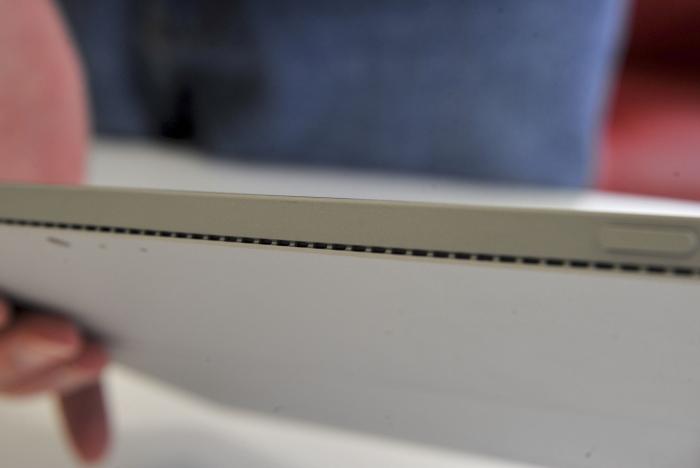
It was only when the CPU was running for a while at over 40 per cent capacity (such as on some Flash-heavy Web pages), that we noticed the fan kick in; it produced a noticeable whirr. Running games and 3D benchmarks also made the fan pipe up, and it goes without saying that during these taxing tasks, you should expect the Surface to be perhaps as noisy as an Ultrabook performing the same tasks. The unit got warm at the top-right side, but did not get uncomfortable to hold.
As mentioned, you can use the Surface Pro 3 as a tablet, and as a laptop, but with the stand built in, you can also use it as a display when you want to watch videos without holding the tablet, or when you want to attach a desktop-sized keyboard and do some hardcore typing at home or in the office. You can sit the screen right up against your mechanical keyboard and it will replicate the desktop feel quite well (monitor size notwithstanding).
There is one full-sized USB 3.0 port built in, so you'll need a hub if you want to attach both a keyboard and a mouse, or you can just go ahead and use a Bluetooth peripheral. Microsoft has a docking accessory as well, which can be considered if you will regularly use the Surface Pro 3 as a desktop device for long sessions of typing and other work that requires more of a traditional feel. A microSD card slot is hidden away behind the kickstand, so you can expand the internal storage, and there is a Mini DisplayPort for attaching to an external display.

One other thing to note about the hardware is that the speakers are front-facing. They reside on each side of the screen (as held in landscape orientation) and they produce a sound that is reasonable for listening to music and watching online clips. Their sound is fired through tiny slits that are formed by cuts that have been made to the very edges of the Gorilla Glass, but you can barely see that they're there.
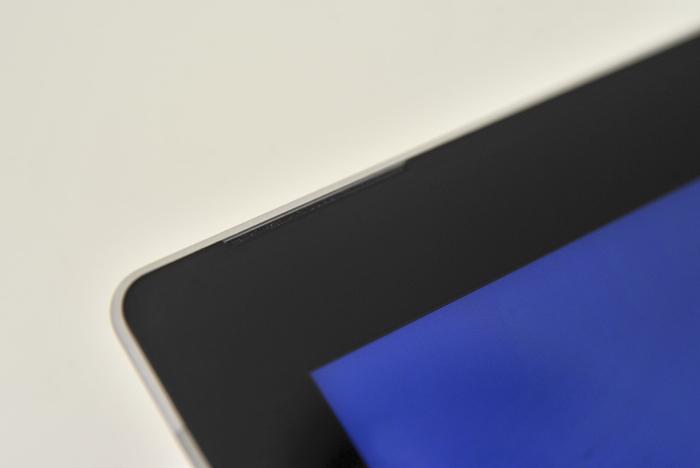
Our usual caveat with the speakers applies, though: for truly great sound, plug in a set of headphones, of tap into a Bluetooth speaker system or Hi-Fi. We had no problems making a connection to our Bluetooth-equipped Rotel amplifier, using Google Play Music to stream music across our 5GHz Wi-Fi network. The Wi-Fi module is a Marvell Avastar that supports 802.11ac, and file transfers peaked at speed of 36MBps when using a Belkin router.
Should you buy it?
If you’ve been waiting for the perfect Windows 8 hybrid device, then the answer is a resounding yes. But make sure you also get the Type Cover if you do want to actually use it as a laptop convertible — without it, there is no convertible experience.
Brand Post

Most Popular Reviews
- 1 Dell U3223QE review: A winning debut for an IPS Black monitor
- 2 HP Spectre x360 16 review: The right 2-in-1 at the wrong time
- 3 Acer K242HYL review: An affordable monitor for any occasion
- 4 GeForce Now review: You bring the games, Nvidia streams the hardware
- 5 Asus ProArt PA279CV monitor review: The go-to for content creators on a budget
Latest News Articles
- Fortnite returns to the iPhone (sort of) courtesy Xbox Cloud Gaming
- iPad buying guide 2022
- Best Mac for music production
- Apple’s 3-meter Thunderbolt 4 cable for AU$249 is the only game in town
- Apple adds two popular classic iPads to ‘vintage’ list
Resources
Macworld
What's new, plus best mac-related tips
and tricks

Business Centre
The latest business news, reviews, features and whitepapers

Videos
Watch our video news and reviews from around the world

Guides
Comprehensive buying guides, features, and step-by-step articles

PCW Evaluation Team
Pedro Peixoto
Aruba Instant On AP11D

Set up is effortless.
Cate Bacon
Aruba Instant On AP11D

The strength of the Aruba Instant On AP11D is that the design and feature set support the modern, flexible, and mobile way of working.
Dr Prabigya Shiwakoti
Aruba Instant On AP11D

Aruba backs the AP11D up with a two-year warranty and 24/7 phone support.
Tom Pope
Dynabook Portégé X30L-G

Ultimately this laptop has achieved everything I would hope for in a laptop for work, while fitting that into a form factor and weight that is remarkable.
Tom Sellers
MSI P65

This smart laptop was enjoyable to use and great to work on – creating content was super simple.
Lolita Wang
MSI GT76

It really doesn’t get more “gaming laptop” than this.
Featured Content
- Which Lenovo Laptop Should I Buy?
- Every TV in Samsung's 2022 line-up: OLED, Neo QLED and more!
- Top 10 best Android and Apple phones for under $600
- Everything you need to know about Smart TVs
- What's the difference between an Intel Core i3, i5 and i7?
- Laser vs. inkjet printers: which is better?










